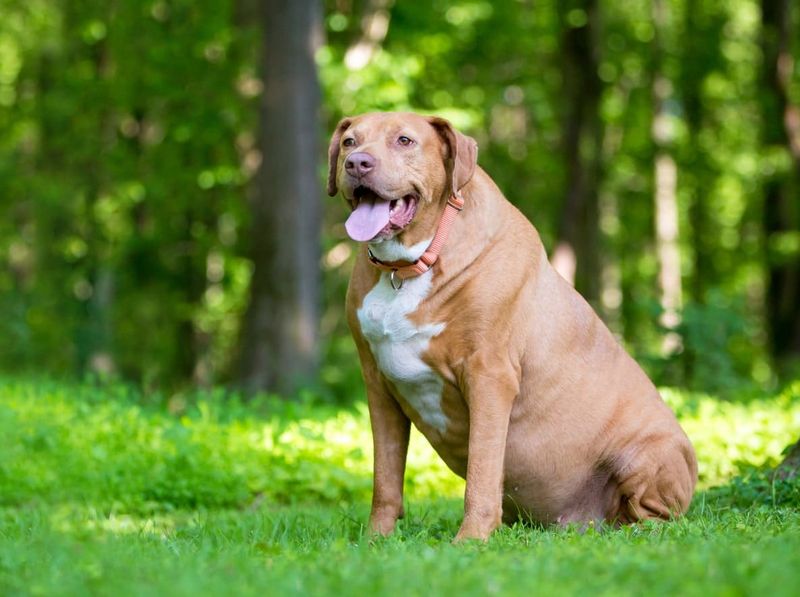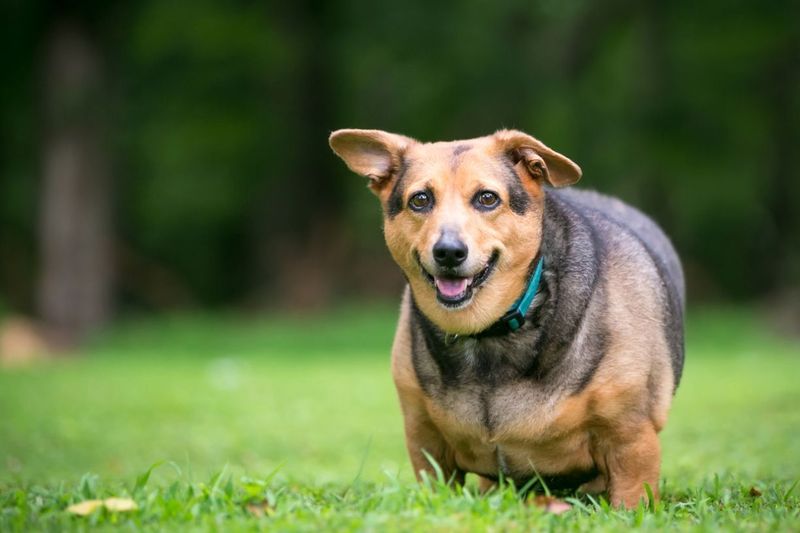📖 Table of Content:
In today’s world, ensuring the health and happiness of our canine companions is paramount. Like humans, dogs can struggle with weight issues, which might lead to severe health complications if not addressed timely.
Recognizing the signs of overweight in dogs is the first step in ensuring their well-being. This guide will help you identify key indicators and provide practical solutions to help your furry friend maintain a healthy weight.
1. Lack of Visible Waist
One of the primary signs that your dog might be overweight is the lack of a visible waist. When you look at your dog from above, there should be a distinct indentation between the ribs and hips, forming an hourglass shape. If this is absent, it’s a clear indication that your dog might be carrying extra weight.
A dog’s waistline is a crucial indicator of their overall health. The absence of a visible waist might mean that there is excess fat accumulation around the abdomen, which can be detrimental to their health.
Monitoring your dog’s shape rather than relying solely on weight scales can provide a more accurate picture of their condition.
To help your dog regain their waistline, consider incorporating more exercise into their routine, such as walks or play sessions. Additionally, consult with a veterinarian to adjust their diet, focusing on portion control and balanced nutrition.
2. Difficulty Breathing
Difficulty breathing or excessive panting during mild activities is another sign your dog might be overweight. Dogs should be able to engage in regular activities without struggling for breath. If your pet shows signs of breathlessness after minimal exertion, it’s time to assess their weight.
The respiratory system of dogs is designed to handle various activities, including running and playing. However, excess weight can strain their respiratory system, making it hard for them to breathe normally.
This issue is not only uncomfortable for the dog but can also lead to more severe health issues if left unaddressed.
To help your dog, start by introducing gentle exercises and gradually increase intensity to build their stamina. Consult with a veterinarian to determine a safe weight loss plan, which might include a balanced diet and regular physical activities tailored to your dog’s needs.
3. Trouble Walking or Running
If your dog is finding it difficult to walk or run, it may be a sign of overweight. Dogs usually exhibit enthusiasm and energy for walks and playtime. However, if your dog seems reluctant or struggles to move around, it could be a symptom of excess weight.
Overweight can put a strain on a dog’s joints and muscles, making movement painful or tiring. This discomfort can hinder their ability to enjoy activities they once loved. Observing any changes in your pet’s mobility can provide insights into their overall health.
To alleviate this, engage your dog in low-impact exercises like swimming, which is easier on the joints. Regular vet check-ups can help monitor their weight and adjust their diet accordingly, ensuring they receive adequate nutrition without excess calories.
4. Frequent Fatigue
Dogs are known for their playful nature and boundless energy. If your dog is frequently tired or seems lazy, it might be due to overweight. Fatigue in dogs can be a sign that their body is carrying more weight than it can handle comfortably.
Excess weight can lead to a decrease in physical activity, causing a cycle of lethargy and weight gain. This cycle can impact their mental health, as dogs thrive on interaction and play. Observing changes in your dog’s energy levels can help you catch weight issues early.
Combat fatigue by ensuring your dog gets regular exercise and a balanced diet. Break activities into shorter, more frequent sessions to keep them engaged without exhausting them.
Consulting a veterinarian for a tailored exercise and diet plan can make a significant difference in their energy and overall well-being.
5. Inability to Groom
An inability to groom effectively is another sign your dog might be overweight. Dogs need to maintain their hygiene by licking and reaching all parts of their bodies. If your pet struggles to clean themselves, this could indicate excess weight limiting their flexibility.
Grooming is vital for a dog’s health, preventing skin issues and maintaining a shiny coat. When dogs can’t groom properly, it can lead to discomfort and secondary health issues. Observing your pet’s grooming habits can provide insight into their physical condition.
To assist your dog, engage them in exercises that promote flexibility and weight loss. Regular grooming sessions with a professional can ensure they stay clean and comfortable while you work on their weight management.
A veterinarian can provide guidance on creating a balanced diet to support their grooming needs.
6. Visible Fat Deposits
Visible fat deposits, especially around the neck and back, are telltale signs that your dog might be overweight. These fat pockets can be easily felt or seen when petting your dog, and they indicate an unhealthy level of body fat.
Fat deposits not only affect your dog’s appearance but also pose significant health risks, including diabetes and joint problems. Monitoring these areas regularly can help you catch weight issues early and take proactive measures to address them.
To reduce fat deposits, incorporate a combination of diet and exercise. Special dog foods aimed at weight loss can be beneficial, and regular vet visits can help you track their progress. Engaging in interactive play and mental stimulation can also aid in burning calories and reducing excess fat.
7. Reluctance to Exercise
A reluctance to exercise or play is a common sign of overweight in dogs. If your furry friend prefers to lounge rather than engage in activities they once loved, it might be due to the discomfort of carrying extra weight.
Exercise is essential for a dog’s physical and mental health. When overweight, even simple activities can become exhausting, leading to a more sedentary lifestyle. This reluctance can exacerbate weight issues, creating a cycle that is hard to break.
Encourage your dog to move by making exercise fun and rewarding. Short, frequent walks and play sessions can gradually build their stamina. Consult with a vet to ensure their exercise regime and diet are aligned with their weight loss goals, ensuring they remain motivated and healthy.
8. Digestive Issues
Digestive issues such as bloating, gas, or constipation can also indicate your dog is overweight. Excess weight often leads to a slower metabolism, affecting how your dog processes food and leading to gastrointestinal discomfort.
A dog’s digestive health is crucial for overall well-being. When overweight, their system may not function optimally, leading to a build-up of gas or difficulty in digestion. This can cause discomfort and affect their mood and energy levels.
To tackle digestive issues, consider adjusting your dog’s diet to include high-fiber foods that promote better digestion. Feeding smaller, more frequent meals can aid in metabolism.
Regular vet check-ups can help in identifying any underlying issues and adjusting their diet and exercise routine to improve their digestive health.








